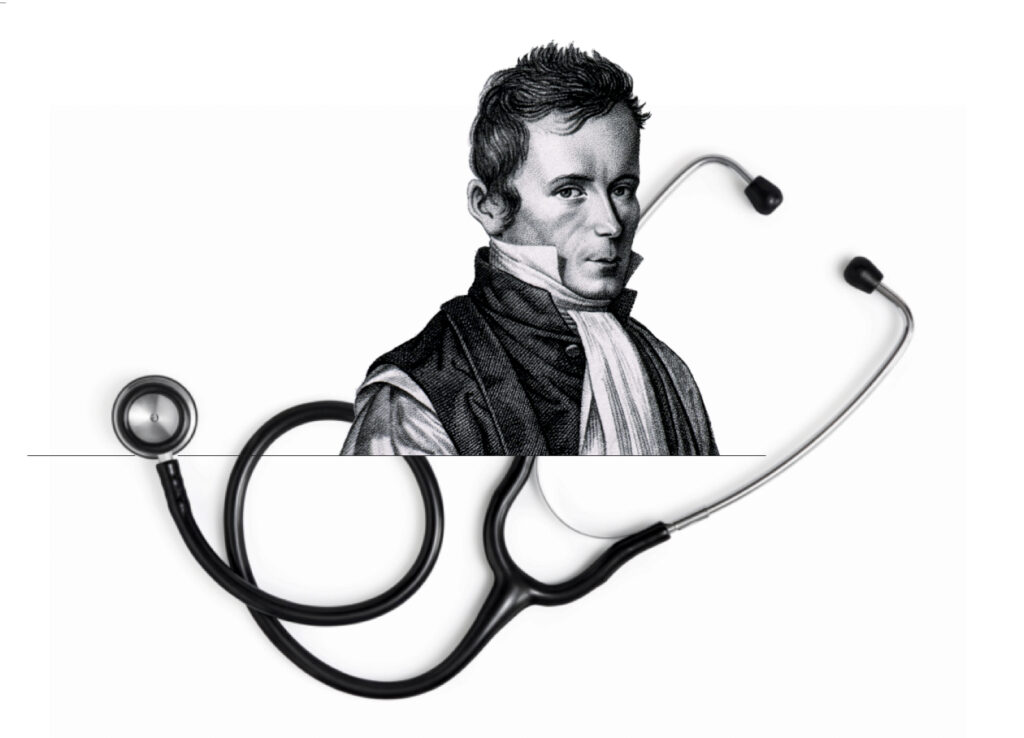Feature
The Stethoscope
The origins and evolution of this humble but essential diagnostic tool.

A FEW YEARS AGO, a familiar piece of medical equipment quietly celebrated its 200th birthday: the humble stethoscope. This is the story of the origins and evolution of this important tool.
Laennec’s Brainstorm
Listening to the sounds of a patient’s heart, lungs, and other internal organs — auscultation — is one of the oldest diagnostic techniques in medicine. However, for centuries, practitioners relied on their ears alone, either laying their head directly on the patient’s chest or applying percussion and listening for the resulting sounds.
The use of an instrument to transmit sound from the patient’s chest to the clinician’s ear was popularized in the early 19th century by Parisian physician René Théophile-Hyacinthe Laennec, who conceived it as a workaround for an awkward situation.
“I was consulted in 1816 by a young woman who presented some general symptoms of disease of the heart, in whose case application of the hand and percussion gave but slight indication, on account of her corpulency,” Laennec later wrote.
Laennec felt that the alternative — laying his head against the patient’s chest — was “rendered inadmissible by the age and sex of the patient.” He then had a brainstorm.
Recalling that a solid beam could transmit sound, Laennec fashioned a crude cylinder out of a tightly rolled stack of paper. Pressing one end against the patient’s chest and the other to his ear, he “was agreeably surprised at hearing the pulsation of the heart much more clearly and distinctly than … by the immediate application of the ear.”
Book and Device: 16 Francs
Over the next two years, Laennec fashioned a more durable and effective version of this tool: a two-piece cylinder of brass and wood with a funnel-shaped opening on one end. He called it a stethoscope, from the Greek “stethos,” meaning “chest.”
Laennec announced his new instrument in 1818 and began marketing it in late 1819 along with a new treatise on the use of auscultation to identify cardiac and respiratory illness. In Paris, the book sold for 13 francs; purchasing a stethoscope along with it added 3 francs (about 60 cents) to the price.
The book was a sensation, selling out multiple printings in French and English. Using the meticulous observations he’d made through the use of his stethoscope, Laennec had devised a whole new vocabulary for chest sounds, coining terms like “rales” and “bruit” and associating them with specific diseases.
Laennec hadn’t merely invented a new device — he’d revolutionized the diagnostic value of auscultation, which would soon make the stethoscope an indispensable medical tool.
The Design Evolves
Although Laennec died in 1826, others hastened to refine his invention. In 1828, Pierre Adolphe Piorry developed a shorter, slenderer stethoscope resembling a two-piece miniature trumpet, with an ivory earpiece on one end and a bell-shaped chest piece.
Variations on this design soon superseded Laennec’s baton-like cylinder, eventually spawning shorter models that could be clipped inside the crown of a top hat or folded to carry in a pocket. There were also longer versions, up to 36 inches, designed to keep the user out of jumping range of a patient’s fleas!
As early as 1829, some clinicians noted that it might be useful to listen with both ears rather than just one. However, the first binaural stethoscopes were delicate and cumbersome to use.
In the 1850s, George Camman developed the first practical binaural design, and one of the first that the average person today would immediately recognize as a stethoscope, with a trumpet-like wooden chest piece connected to two flexible woven tubes and two silver ear tubes. The Camman stethoscope became popular in the U.S. after the Civil War.
“A Doctor’s Stethoscope”
Prior to WW1, it was customary for a physician to use the stethoscope while a nurse took notes. By the 1930s, nurses often used stethoscopes themselves for blood pressure and other assessments.
Some manufacturers later began marketing stethoscopes specifically for nurses, like the Winley-Morris Assistoscope and the Littmann Nursescope, which both arrived in the 1960s — 50 years before “The View” host Joy Behar outraged nurses by lambasting Miss America contestant Kelley Johnson, RN, for wearing “a doctor’s stethoscope.”
Future Form and Fabrication
The now-familiar Littmann Stethoscope debuted in 1961. Its inventor, cardiologist David Littmann, M.D., built the first prototypes in his basement! The 3M company continues to market Littmann-branded stethoscopes today.
Some of the stethoscope’s traditional duties are now being assumed by newer diagnostic tools and devices. Electronic stethoscopes, which convert sound waves into electrical impulses, have been around for almost a century, but the latest models offer greater sensitivity, rec-ording ability, and automated diagnostic aids.
Such advances might make the traditional stethoscope seem old-fashioned, but don’t count it out yet. While learning to use one takes practice (as every nursing student knows), a stethoscope is a robust, portable tool that won’t fail you if the network is down or the power is out.
One exciting recent stethoscope development focuses not on function, but on fabrication. The Glia Project has developed an open source, 3D-printable ABS plastic stethoscope that offers acoustic performance comparable to a Littmann Cardiology III, but can be produced for less than $10.
That’s an attractive combination for healthcare organizations throughout the global south, and one that could ensure the stethoscope a place in medical toolkits for another century.
AARON SEVERSON is the associate editor of Working Nurse.
In this Article: Historical Nurses, technology


